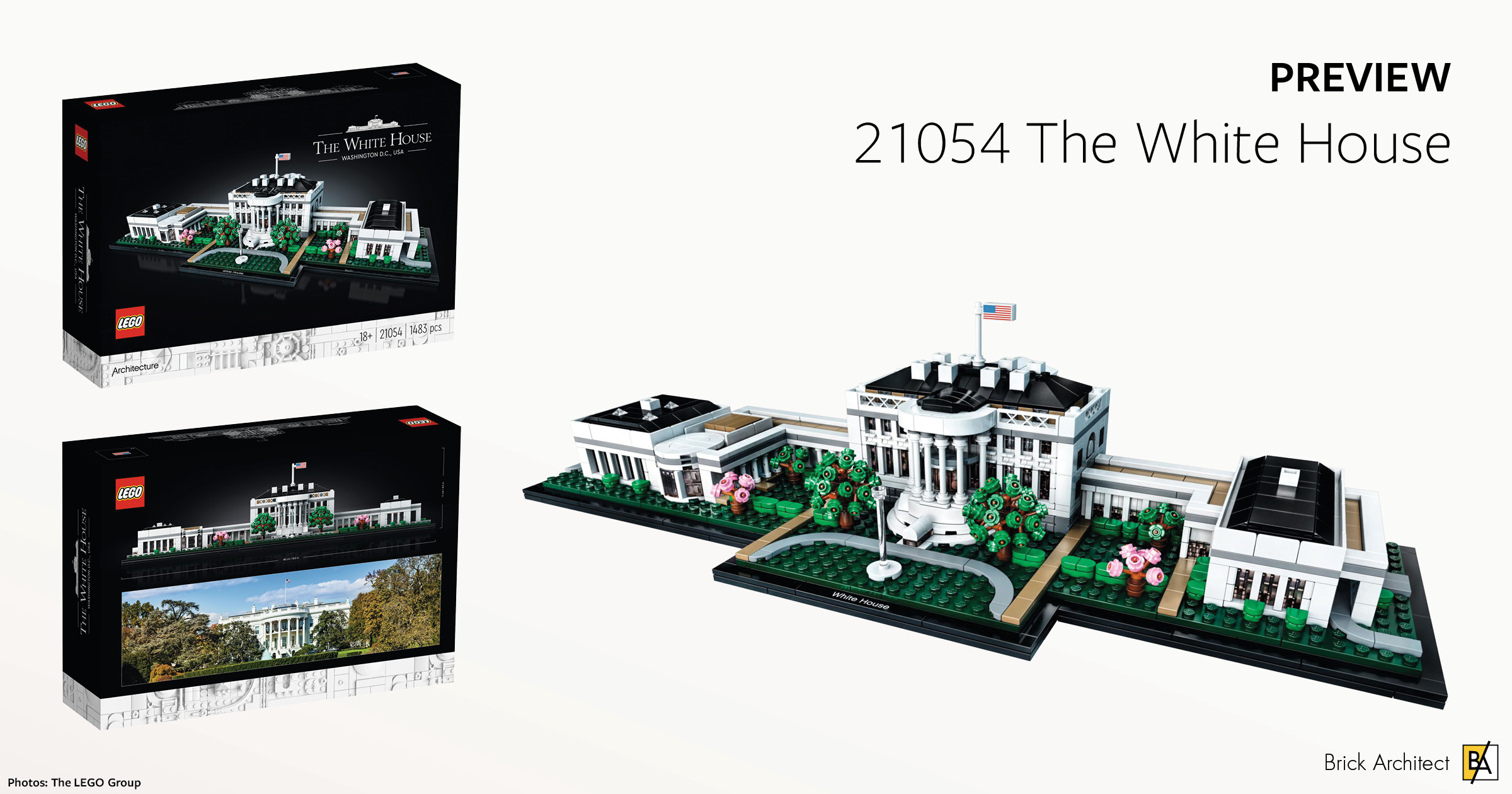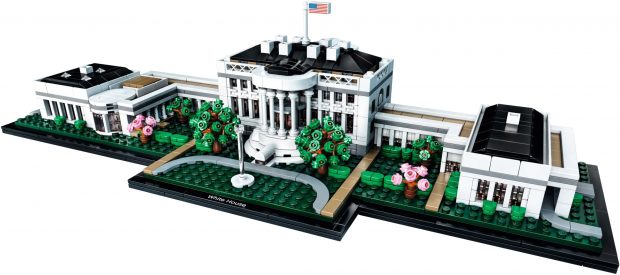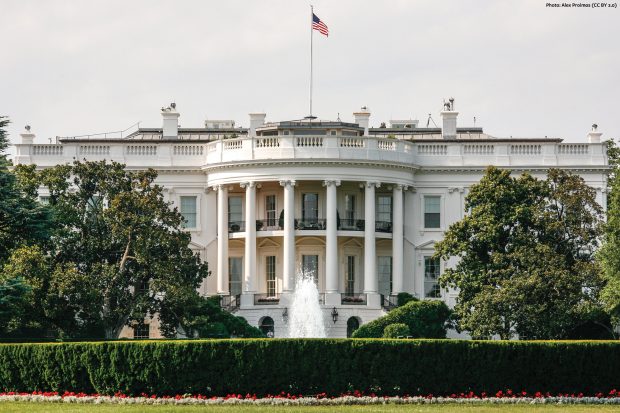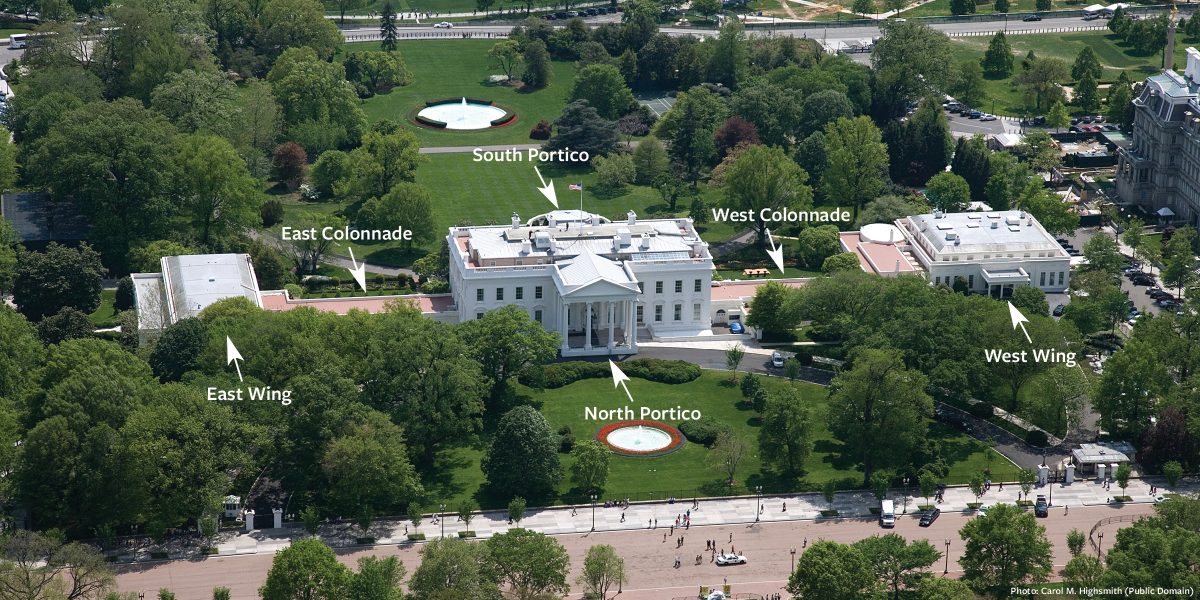Preview: #21054 The White House
This summer, an updated version of The White House will be released which includes the East and West Wing. Let’s take a sneak peek at the new set (and the new packaging designed to appeal to Adult Fans of LEGO).
June 6, 2020: Read our review of #21054 The White House!
(The set was released in Europe and Asia on June 1, and will be released in North and South America on August 1.)
Since the LEGO Architecture Skyline series debuted in 2016, two or three Skylines were released in January, followed by two or three larger standalone models in the Summer. So far, only one large standalone model has been announced for 2020, and it isn’t even a new building for the series.
Instead, they are releasing an updated version of 2010’s #21006 The White House. I am pleased to say that it is a pretty significant refresh to the earlier design, utilizing more advanced building techniques and more intricate construction (made possible by some new parts which didn’t exist in 2010).
The previous #21006 The White House model was released 10 years earlier (July 2010). While we do not have a firm release date yet, it’s well known that is an election year in the United States. While The LEGO Group has made questionable choices in the past, they are the world’s largest toy company so we should assume that their decision to release a new version of The White House during the most polarizing presidency in history was intentional. As The White House is literally the home of the president, I’m surprised that they decided that this was the right time to tackle a political subject like this.
Nonetheless, let’s focus on the architectural merits of the building, and the technical aspects of this updated version. The new version contains 1483 pieces (versus 560 pieces in the previous version). The larger part count is easily attributable to the addition of both the East Wing (containing office space for the first lady and her staff, and the visitor’s entrance) and West Wing (containing offices for the president including the iconic oval office).
The Architecture
The building’s architectural pedigree is strong but mixed. This is due to the large number of remodels and extensions which have occured since the central building (designed by architect James Hoban) was completed in 1800. Now serving as the executive residence, the central building blends the simplicity of Neoclassical architecture with Palladian influences such as strict proportions and the rusticated lower levels.
A few years later, talented amateur architect (and US President) Thomas Jefferson added the east and west colonnades to conceal domestic functions of the building. (Jefferson’s home at Poplar Forest also concealed cooking and laundry facilities in a partially hidden colonnade on the east side of his octagonal country home.)
The interior had to be rebuilt after it was burned in the War of 1812. Soon thereafter, Hoban returned to design the elliptical South Portico (1824), and rectangular North Portico (1830). While numerouos interior remodeling project followed, this finalized the central building’s exterior appearance.
In 1902, Theodore Roosevelt brought on Charles McKim to design the West Wing, providing office space for the executive staff. The iconic Oval Office was added to the West Wing in a subsequent 1925 remodel by Nathan Wyeth.
A small East Wing was also added in 1902, the current East Wing was built in 1942 to house the offices of the First Lady and guest entrance (and to hide the construction of an underground emergency bunker).
While the White House complex is not the realization of a single architects master plan, it is a pleasing composition of three buildings connected through a similar visual style and a lateral collonade.
The LEGO Model
The obvious difference between this new version and the original model is the inclusion of the East and West Wings. In addition to additional architectural details, this results in a significant amount of additional landscaping, the curved driveway on the south facade, and the tall fountain visible when viewed from the National Mall. The resulting composition is reminiscent of another Washington DC landmark, #21030 United States Capitol Building.
Scale
On first glance at the new model, one thing stood out to me; the proportions of the central building do not look right. In both #21006 and the new #21054 versions, the central building is 8-studs deep (excluding the porticos), and about 19 plates tall (excluding the roof). Surprisingly, the older version 24-studs wide whereas the new one is just 16-studs wide (That’s 50% wider than the new one.) We’re going to need to do some math to determine which one is wrong.
Thankfully, it was easy to find the comparable dimensions of the real building: “168 feet (51.2 meters) long, 85 feet 6 inches (26.1 meters) wide without porticoes, and the faade (grade of lawn to parapet) is 60 feet on the south (lawn at 54 feet above sea level).”
Let’s calculate the scale:
- Building Depth:
26.1 m × 100 (cm/m) = 2610 cm
8 studs × 0.8 (cm/stud) = 6.4 cm
2610 cm / 6.4 cm = 408 (or 1:408 scale) - Building Height:
18.2 m × 100 (cm/m) = 1820 cm
19 plates × 0.32 (cm/plate) = 6.1 cm
1820 cm / 6.1 cm = 298 (or 1:298 scale) - Building Width (#21006):
51.2 m × 100 (cm/m) = 5120 cm
24 studs × 0.8 (cm/stud) = 19.2 cm
5120 cm / 19.2 cm = 267 (or 1:267 scale) - Building Width (#21054):
51.2 m × 100 (cm/m) = 5120 cm
16 studs × 0.8 (cm/stud) = 12.8 cm
5120 cm / 12.8 cm = 400 (or 1:400 scale)
What these calculations reveal is a fairly large discrepancy between the building height and depth in both versions of the model (1:408 based on depth, versus 1:298 based on height). Those proportions could be improved by either increasing the height of the model, or decreasing the depth of the model.
When it comes to the width of the model, I’m most concerned that it is close to the same scale as the height, since the model will typically be viewed from the front. Since the height results in a 1:298 scale, the 2010 version’s 1:267 scale (based on width) has more realistic proportions when viewed from the front.
Since the new version has a 1:400 scale based on width and a 1:408 scale based on depth, the “easiest” fix would have been to reduce the height of the building by 4 or 5 plates, resulting in a scale of 1:380 or 1:406 respectively. Naturally, it is easier said than done to preserve adequate detail when reducing the size of a LEGO Model. (Alternately, they could make the entire model larger to accomodate a wider and deeper central building.)
Parts & Building Techniques
As is typical of sets in the LEGO Architecture series, I do not see any new parts in the model. Ocassionally, we do see existing parts appearing in a new color, so we’ll have to wait and see when the set is released.
That said, I immediately noticed a new printed part: 1×2 Tile w/ USA Flag (part 3069). This is the first time the American flag is offered at this size, and will no doubt be popular with fans.
Two building techniques caught my eye that I want to highlight. The first is the extensive use of SNOT for the windows of all three buildings. Even the windows of the Oval Office are implemented using a SNOT assembly containing three plates and two Cheese wedges.
The second detail that made me smile were the chimneys, which appear to be White 1×1 Bricks which are upside-down. I’m not sure how they are attached internally, but I think we can all agree that this looks much better than the visible studs on original 2010 version.
More articles like this?

Subscribe to the Brick Architect newsletter for early access to exclusive content, the latest articles, and updates to the Printable LEGO Brick Labels, LEGO Storage Guide, and my book The LEGO Architect.
Packaging
You also might have noticed a significant facelift to the packaging. We’re used to LEGO Architecture sets which come in an austere black box with a front flap. (We can’t tell from the rendered box art if we still get a box flap, or if they’ve abandonded it in favor of a cheaper box with end flaps.)
Instead, we see a slender band of white bricks along the bottom of the box, containing facts about the set: recommended age | set number | part count. (This minimalist style debuted earlier in the year with three buildable Star Wars helmets.)
Speaking of which, this is the first set in the Architecture series targeting ages 18+ (every previous set in the LEGO Architecture series had a recommended age of 12+ or 16+). I do not think that this change reflects an increased degree of difficulty. Instead, it’s part of a 2020 branding plan to create sets and packaging targeting Adult Fans.









Is the set still releasing June 1st or did it get delayed
June 1 in most of the world, August 1 in North and South America.
When will the set be released? Its August 7th!
USA / North America release delayed due to COVID impact on the LEGO factory in Mexico. That’s why it simply says “coming soon”.
Lego, a strange Danish enigma…trying to bang the buck whilst its Chinese competitors are offering equal or better quality products often much cheaper…
They just seem to be tourist attractions now, haven’t done an architecturally interesting building that wasn’t a remake since the Flatiron in 2015.
Even Flatiron was a strategic play, since that set came out about the same time as a new LEGO Retail Store in that part of NYC.
That takes us back to 2013, the Imperial Hotel and the rumoured Eames house cancellation. Looks like a decision was taken then that old architecturally significant buildings would not sell, unless tourists flocked to them.
Regarding the new box design, that certainly isn’t too important to me, but I probably liked the older design more. And I really hope they don’t make the boxes normal rip open LEGO boxes. A sturdy reuseable and properly openable box transports a certain idea of value, while making zero difference to LEGO regarding production cost. The 18+ I consider largely marketing BS, but age “requirements” were never much of a logical thing anyway.
I have to reiterate that for me this is largely a remake the world doesn’t need. Yes, it looks nice and uses a lot more SNOT than the Adam Reed Tucker building. But even for a more abstract Landmarks series set I think the old one still holds up well next to more modern models like the Capitol. It’s not like the White House offers such a huge canvas for intricate detail. Earlier remakes, like the Empire State or the Guggenheim were a lot more understandable and different.
And more than that, the old model had just the right size for an Architecture set. Okay, it might be more accurate with the side wings, but I don’t need the Architecture models growing to Creator Expert sizes, neither size-wise, nor parts-wise, and surely not price-wise (although, initial rumours suggested even more parts and this just about scratches the upper size threshold rather than crossing it too much).
The collector in me definitely buys this and disregarding the remake fact and the size concerns, it certainly is quite beautiful, but the by-taste and general disappointment remains. I’ll hold my hopes for the 2nd one that’s supposedly coming this year, hopefully a new building and a bit smaller.
Ugh, they need to stop doing remakes! And, it seems like the Architecture series is slowing down with now only 2 skylines/1 landmark in a year…unfortunate.
UGH! Lego, stop rehashing the older builds! Give us new unique buildings, there are millions of them out there!